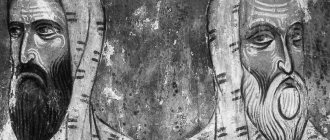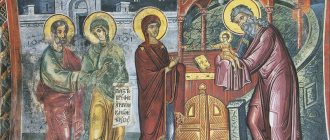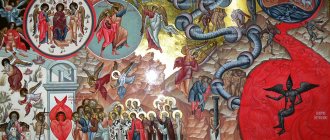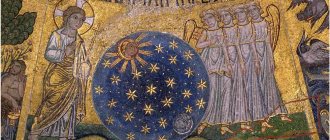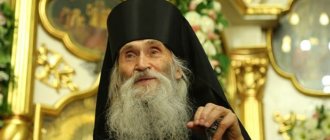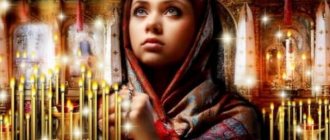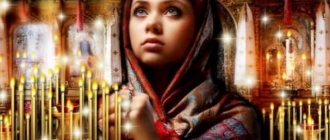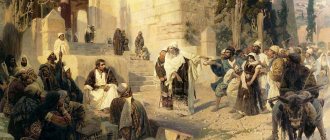The Old Testament hierarchy established by God had three levels. The highest level of the Israelite priesthood belonged to the high priest.
In the book of Leviticus the name cohen-gadol appears for the first time, which literally means “great priest.”
The high priest (ha-kohen, ha-gadol, kohen-gadol) is a priest who led the service in the tabernacle, then in the First and Second Temples of Jerusalem.
Aaron
first of the high priests
The epithet “anointed one” (mashiach) was applied to the high priests, because ordination was accompanied by anointing with oil.
The rite of initiation into high priesthood lasted 7 days.
The rite of initiation into the high priest and priest consisted of four actions:
- ablution with water. The Jewish high priests took such a bath on the holiday - the day of Atonement. This was not only a physical, but also a symbolic action, signifying the holiness and purity of the future minister;
- vestment in sacred clothes. The symbol of the service into which the initiate entered;
- anointing with sacred oil. Oil is considered a symbol of joy and a sign of God's blessing, and the gifts of the Holy Spirit were given through anointing. According to legend, Moses poured a large amount of oil on Aaron's head and then anointed his face and clothes. For priests, only the face and clothing were anointed;
- sacrifice. Three sacrifices were offered: for sin, a burnt offering, and a special sacrifice of dedication.
The initiation ceremony lasted seven days and ended with a meal symbolizing the union of the initiates with God.
8 types
clothes worn by the high priest during the service
The clothing of the high priest was more majestic than that of ordinary priests and consisted of eight types: four types of clothing that belonged to the ordinary priestly attire (the so-called “white robes”), and four additional ones that only he wears (“golden robes”). .
Spiritual prototypes: 9 facts
High Priest, type of Christ. 9 facts
High Priest
- The High Priest could not have any physical deformities or defects and was required to avoid touching any dead body (Lev. 21:9-23)
- The high priest did not take part in worldly affairs
- The high priest underwent consecration before his ministry - washing with water, anointing with oil and offering a sacrifice to God (Ex. 29: 4,7,10-14)
- The High Priest performed annual reconciliation for the people (Lev. 16:3-16; Heb. 9:7-14)
- The high priest interceded for the people (Lev. 16:3-16)
- The high priest blessed the people in the name of the Lord
- The high priest had oversight of the tabernacle (Heb. 9:6,7)
- The high priest passed judgment and made decisions in controversial matters (John 18:13)
- The high priest had a successor after death (Heb. 7:23)
Jesus
- Jesus, our high priest, was holy, innocent, free from evil, separated from sinners. There was no defect in His character (Heb. 4:15; 7:26; 1 Pet. 2:22).
- Jesus was busy doing God's will (John 6:38)
- Christ was baptized, anointed with the Holy Spirit, and offered Himself as a sacrifice (Matt. 3:13-17; Heb. 9:26)
- Christ made one reconciliation for the whole world (Heb. 9:7-14; 10:9,10)
- Christ intercedes for us (Heb. 7:25; 1 John 2:1-3)
- Christ has blessed us with the forgiveness of sins (Acts 3:26; 2:38)
- Christ is at the head of the church (Heb. 10:21)
- Christ has all power and authority (Matt. 28:18)
- Christ has no successors, for He lives (Heb. 7:24,28)
Moses himself ordered the sacred garments to be made.
Sacred Robes of the High Priest
Moses himself ordered the sacred robe to be made:
“These are the garments that they must make: a breastplate, an ephod, a robe, a tunic, a turban, and a girdle.
Let them make holy garments for Aaron your brother and his sons, that he may be a priest to Me.”
(Ex. 28:4)
Confidant, Choshen
The breastplate was a four-cornered breastplate with 12 gold-set precious stones, forming four rows of three stones each, on which were engraved the names of the 12 tribes of Israel.
“The ephod (ephod) was two pieces of cloth woven of blue, purple, and scarlet thread, fine linen, and gold (in the form of threads).
The ephod covered the priest's back and chest and symbolized the responsibility that fell on his shoulders.
The ephod was tied together with a long belt, the symbolic meaning of which can also be found in the Bible: gird your loins.”
(2 Kings 9:1)
What did it mean to be ready to work?
Ephod. High Priest's Robe
A blue robe was worn over the tunic and under the ephod. The outer robe had no sleeves and was toe-length. The hem was decorated with pomegranate apples and bells
“so that a sound may be heard from him when he enters the sanctuary before the Lord and when he goes out, so that he does not die.”
(Ex. 28, 35)
The turban or turban resembled the headdresses of other priests and differed only in that a diadem of holiness (tsits) was attached to it - a golden half-hoop with the inscription “holy of the Lord.”
“And he put the miter on his head, and on the miter on the front of it he placed the polished tablet, the diadem of the holy thing, as the Lord commanded Moses.”
(Lev.8:9)
Circlet of Holiness
The position of the high priest was honorable and respected, so he was subject to strict requirements regarding personal purity and holiness: he could not marry a widow, touch the dead, or bare his head.
“But the great priest of his brethren, on whose head the anointing oil is poured, and who is sanctified to put on the [sacred] garments, must not uncover his head or rend his garments; and he should not approach any dead person: even by [touching the deceased] his father and his mother, he should not defile himself.
And he must not depart from the sanctuary and dishonor the sanctuary of his God, for the consecration of the anointing oil of his God is upon him.
I am the Lord. He must take a girl as his wife. he must not take a widow, or an outcast, or a defamed woman, [or] a harlot, but he must take a maiden from his people to wife; he shall not disgrace his seed among his people, for I am the Lord who sanctifies him.”
(Lev. 21)
83 people
occupied a high position during the years of the existence of the institution of the high priesthood
High priests were appointed to this position for life, but in the last years of the kingdom of Judah this high position was occupied at a time by several high priests, people of bad morals and vicious people, such as, for example, the Old Testament Caiaphas.
It is almost impossible to compile an exact list of high priests, because... The data that has reached us is insufficient and may not be accurate. But according to Josephus it is about 83 people.
By leaving a comment, you accept the user agreement
Appointment of the High Priest and procedure for his ordination [↑]
According to Jewish law, the High Priest is appointed by the Supreme Court of Torah sages, the Sanhedrin. Initially, you should choose the most powerful, rich, handsome and intelligent kohan for this position. If he is not rich, but meets the other requirements for this post, other kohanim are obliged to provide him with money.
The High Priest is consecrated by anointing with special oil. If there is no anointing oil, he can be consecrated by wearing the eight special high priestly robes. Initially, the process of anointing with oil or donning the eight robes should last seven days (where he is anointed anew or donning the eight robes anew every day), however, after the fact, even if he is anointed or dons the eight robes for only one day, he is considered a high priest.
There is practically no difference between a high priest who has been ordained by anointing and one who has been ordained by putting on the eight garments, except that the sacrifice of an ox for his unintentional sin is offered only by the high priest who has been ordained to that office by anointing.
Content
- 1 General information
- 2 High Priests of the Tabernacle Age
- 3 High Priests of the First Temple
- 4 From the return from captivity to Alexander the Great
- 5 Under the Seleucids
- 6 Hasmoneans
- 7 Under Herod
- 8 Under Archelaus
- 9 Under Quirinius
- 10 Under Valeria Gracia
- 11 Under Vitelius
- 12 Under Agrippa I
- 13 Under Herod of Chalcis
- 14 Under Agrippa II
- 15 Sources
The Very First of the High Priests: Most Worthy Servants
When the Mishkan was built in the desert, it was necessary to ensure that the service in it was carried out impeccably, and a High Priest was appointed for this purpose. Moshe was originally supposed to take on this role, but according to some commentators, (1) he forfeited his right when he refused to be God's messenger to carry out the mission to free the Jews from Egypt. And although his intentions were pure - he wanted to avoid the humiliation of his older brother, because it was about taking on a more significant role than could be assigned to Aaron, his reaction demonstrated that his brother's honor was more important to him than command The Most High, but for the High Priest this was unthinkable, because his position required complete submission to God. (2) So instead of Moses, Aaron became the first High Priest in history.
The high priesthood was to be passed on from father to son, except in cases where the child, due to some of his characteristics, was not suitable for service. (3) After the death of Aaron, this position, at the behest of the Most High, was assumed by his son Elazar, (4) and then she passed to Elazar's son Pinchas. He was the high priest during the people of Israel's conquest of the Promised Land.(5)
Pinchas received the high priesthood as a reward for his devotion to the faith and the Almighty, (6) and his family received the right to inherit this position. However, the privilege was later temporarily revoked and granted to the descendants of Ithamar, Aaron's youngest son. This was the result of two glaring mistakes made by Pinchas during the reign of Iftah (988–982 BC).(7)
The earliest known high priest in the family of Ithamar was Eli, who served in the Mishkan while the Sanctuary was still at Shiloh.(8) After its destruction, the Mishkan was rebuilt in Nov for 13 years(9), and then for 44 years(10) it was in Givon.
In 832 BC. King Shlomo built the First Temple (it took 7 years to build) - on Mount Moriah in Jerusalem. (11) And the first high priest to serve in the Temple was Zadok, (12) a descendant of Pinhas. (13) From then on, the high priesthood was transferred to his family from generation to generation until the construction of the Second Temple.
What work did the High Priest do in the Temple? [↑]
All work in the Temple (sacrifices, burning incense, lighting the temple lamp - the Menorah, etc.) was drawn by lot between the clergy - kohanim (since there was not enough work for everyone, but everyone wanted to participate). The high priest had an advantage - he could choose any of them. Burning incense was considered especially rare and honorable: an ordinary kohen received this work only once in his life, and it brought him wealth. But the Kohen Gadol could even choose it for himself whenever he wanted.
In addition, there were obligatory works that were performed by the Kohen Gadol. Every day (morning and afternoon) he offered a flour sacrifice called "havitin"
- a flatbread made from wheat flour mixed with olive oil and a small amount of fragrant resin. Part of this cake was burned on the altar, the rest was intended for the Kohanim.
If the Kohen Gadol unintentionally committed a sin, for the intentional commission of which he would be entitled to karet (cutting off the soul in the Hereafter and early death), he had to sacrifice an ox, unlike the rest of the Jews, who in this case had to sacrifice either goat or lamb. The sacrifice of the high priest was the most significant, because... he was responsible for the whole people, and his sin was akin to goring a bull (but, as mentioned above, this only applied to the high priest, consecrated by the rite of anointing).
But the most important duty of the high priest was his service on Yom Kippur - the Day of Atonement, when he was actually the representative of the entire Jewish people before G-d and had to do all the work alone.
High Priest status: responsibilities, prohibitions, privileges [↑]
As you know, an accidental killer fled from a blood avenger in a special city of refuge, where he was supposed to live until the death of the high priest. So that that person would not pray for Kohen Gadol to die quickly, the high priest’s mother sent him food and clothing ( see treatise of the Babylonian Talmud “Makot”, l.11A
). But we know that vain curses do not achieve their goal. This means that the high priest was still guilty - guilty of not praying enough for the good of the world and, accordingly, the possibility of such cases (accidental murders) arose. It was within his power to influence the world in such a way that someone who does not want to kill anyone would not do so: his negligence alone would not be enough to lead to murder.
The responsibility of the high priest also manifested itself on Yom Kippur. If his service was displeasing to G‑d, he would perish upon entering the Holy of Holies. Therefore, a chain was tied to the high priest’s leg: if he died, he could be pulled out by it. Such cases often occurred during the Second Temple era, when the standard of the people had fallen so low that the high priesthood was bought with money.
His status as a high priest imposed certain prohibitions on him, in addition to what was prohibited for ordinary kohanim. Thus, if an ordinary priest could not marry a divorced woman, the high priest was forbidden to marry not only a divorcee, but also a widow. He was also forbidden to defile himself with any dead body, even if his close relative died (which is allowed for an ordinary kohen).
However, the high priest was allowed (and even required) to have a “met mitzvah”
- a commandment to bury a deceased person who has no one else to bury.
The privileges of the high priest were that he could, if he wished, make any sacrifice and perform any work in the Temple - ordinary kohanim had to yield to him. When the meat of the sacrifices was divided, the Kohen Gadol could take half and choose the best part for himself.
Ordinary kohanim had to show honor to the high priest. They addressed him with the words "Ishi Kohen Gadol"
- i.e. "My Lord Kohen Gadol." When he went somewhere, the kohanim accompanied him; The high priest should not have walked surrounded by ordinary Jews.
The Kohen Gadol had to behave with dignity. He should not have been seen in the bathhouse or in the restroom, or when he was cutting his hair.
He could only be judged by the Supreme Court of 71 judges - the Sanhedrin, which sat on the territory of the Temple.
High Priest Service on Yom Kippur [↑]
During this holy day, the Kohen Gadol performed a temple service that atoned for the sins of the Jewish people, and ultimately the entire world.
The central moment of this service was the entry of the High Priest into the Holy of Holies of the Temple (this could only be done by one person - the Kohen Gadol - and only one day a year - on Yom Kippur), when he burned incense and sprinkled the blood of sacrificial animals towards the lid of the Ark of the Covenant, and also pronounced the unpronounceable Four-Letter Name of the Most High.
Another important part of the day's service was the sending of one of two identical goats to a desert area, where it was thrown off a cliff (the second goat was slaughtered and offered as a sacrifice). In fact, what happened to the “scapegoat” (in the original it is called a little differently - “the sending goat”) was the materialization of the atonement for sins that took place at the end of Yom Kippur - at the moment when the goat was thrown off, the scarlet cloth turned white, which was tied to the gates of the Temple.
The Yom Kippur service was only counted when performed by the High Priest.
[edit] Sources
- KEE, volume 6, col. 377–378
- Lev. 4:3,5,16, etc.
- Ref., 28, 1, 2; 29, 4, 5
- Lev., 6, 15; Wed Josephus, Ancient., XX, 10, § 1
- I Kings, 2, 35; I Chron., 24, 2, 3
- Jad, l. pp., 16, 17
- Wed Number, 35, 25, 28
- Ex., 29; Lev., 8
- Numbers, 27, 20 et seq.
- Lev., ib.
- Lev., 6, 14-15
- Jad., l. p., V, 7
- Ioma, I, 2; Jad, l. p., V, 12
- Ioma, 60a; Wed ib., 68b
- Ioma, I, 1
- Josephus, Ancient., XII, 5, § 1
- II Macc., III, 4; IV, 23 et seq.
- Josephus Flavius, Contra Αр., Ι, § 7
- Ancient., XIII, 10, § 5; Jellinek, Bet ha-Mid., I, 33; Kid.; 66a
- Lev., 21, 13-14
- Ioma, 13a, Jad., lc,V, 10
- Sang., II, 1
- Lev., 21, 10 et seq.
- Ancient, XV, 3, § 1
- Jad, l. p.,, 20; Ket., 103b; Sifra, Kedoschim
Urim and Thumim [↑]
The ephod and choshen played an important role in the life of the Jewish people.
The ephod was like an apron, worn at the back, so that a belt and shoulder pads (like an epaulette) were in front. An onyx gemstone was set into a golden socket on each shoulder pad. The stones were engraved with the names of Jacob's twelve sons in the order of their birth, six on each.
A choshen, a breastplate, was attached to the shoulder pads of the ephod. Through two gold rings on its upper edge were passed gold chains, which were attached - at two ends each - to the golden cells on the shoulder pads in front, and through two gold rings on its lower edge were passed two threads of blue wool, which were attached to the gold rings on the lower ends of the shoulder pads, those. behind.
The hoshen (breastplate) was a double square with a side of half a cubit, inside of which was placed a parchment with the unpronounceable Name of the Most High, consisting of seventy-two letters.
On the outside, 12 golden holes were inserted into the choshen, in four rows of three holes each: three - according to the number of our forefathers Abraham, Isaac and Yaakov, and four - according to the number of our forefathers Sarah, Rivka, Rachel and Leah.
A precious stone was placed in each hole. In the first hole of the first row there was a ruby (red stone). The name Reuven was engraved on it (hence the name of the stone - ruby). In the second hole there is a green topaz with the name Shimon, in the third there is an emerald with the name Levi.
In the second row were a carbuncle, a sapphire and a diamond with the names of Judah, Issachar and Zebulun.
The third row contained yakhont, agate and amethyst with the names of Dan, Naphtali and Gad.
In the fourth row, the names of Asher, Yosef and Binyamin were engraved on peridot, onyx and jasper, respectively.
It was required that all 22 letters of the Hebrew alphabet be engraved on the stones, but the names of the twelve sons of Jacob lack the letters het, tet, kuf, and tzadi. Therefore, on the first stone the names of Abraham, Isaac and Jacob were additionally inscribed, and on the twelfth - the words “Shivtei Yeshurun”
.
When it was difficult for the Jews to decide what to do: fight or avoid conflict, leave a place or stay, etc. - the answer was found out using the letters of the choshen. The High Priest stood facing the Ark of the Covenant, and the questioner stood behind, and asked a question. The holy spirit took possession of the high priest, and certain letters on the stones of the choshen began to stand out especially in his eyes, and he composed words from them. For this purpose, all the letters of the alphabet were present on the choshen.
The inscription of the name of the Most High, which was placed inside the choshen, made clear (illuminated) the answers of the choshen, therefore all this together was called Urim and Thumim
(
“Urim”
- giving light,
“tumim”
- giving an exhaustive answer, from the root
“there”
, which means “complete”, whole).
And the choshen itself was called “choshen mishpat”
, since the final decision (
mishpat
) in each doubtful case was made with the help of the Urim and Tumim.
During the Second Temple it was no longer possible to receive the answer through the Urim and Thumim.
High Priest's Offering: Clothes, Oil and Bread
The Torah describes in as much detail as possible the inauguration of the first high priest in history. The children of Israel gathered at the Mishkan. Moshe, the temporary Cohen HaGadol, performed the sacrifices. Then he dressed Aaron and his sons in priestly robes, anointed them with special oil, and applied drops of the blood of the sacrificed animals to their ears, fingers, and toes.(52) Aaron and his sons brought the inaugural gift of flour - it had to be boiled, baked and roast before burning on the altar.(53)
In subsequent inaugurations of the high priests, only the anointing of the chosen one, dressed in all 8 special items of clothing, with the help of special oil ( shemen ha-mishcha)
), as well as the inaugural gift of flour (
minchat chinuch
) of the person taking office.
When a Cohen HaGadol vacated office (was injured or died), the Sanhedrin (Jewish Supreme Court) determined whether he had a son equal to him in wisdom and fear of Heaven. If the fear of Heaven was sufficient, the son was appointed to this place, even if he was inferior to his father in wisdom.(54)
However, if the son of the high priest was not suitable for the position or had other ambitions, the Sanhedrin looked for a candidate among the rest of the priests.
The term Kohen HaGadol literally translates as “great priest.” The Talmud says that he was to be the greatest in piety, strength, beauty, wisdom and wealth. And if the court found someone who met all the requirements, but was not rich, the other kohanim would increase his wealth at their own expense.(55)
For 7 days, the one who was chosen as the high priest was dressed in 8 garments, he was anointed with the oil of anointing, and he served in the Holy Temple.56 However, according to another opinion, his service in the Temple continued for 6 days - until the 7th day.(57 )
On the 7th day, the candidate burned the inaugural gift of flour, which he offered with the daily sacrifice of the high priest ( minchat chavitin
), and became a full-fledged Cohen HaGadol.
During the period of the First Temple, when they read the prophecy: “God will take you and your king, whom you will set over you, to a people whom neither you nor your fathers knew,” (58) - King Yeshaya saw an ominous sign in these words and buried the anointing oil, fearing that it would be lost forever.(59) From then on, the inauguration of all high priests took place only using 8 garments and the gift of flour.(60)
Kabbalah about Aaron: "helper of the bride"
In the spiritual union between God (the groom) and the Jewish people (the bride), Moshe and Aaron played different roles.
Moshe represented absolute truth and was meant to help people see reality from the Divine perspective.
God is not affected by time and space. Even though He created the world, this creation did not change Him in any way, as it is said: “As You were before the creation of the world, so You remained after its creation.”(68)
From this transcendental point of view, the world is not as it appears. When we look out the window, we don't see trees and birds; we see God in the form of trees and birds. This worldview is comprehensive. Our individual paths and lives belong to a higher reality that unifies all experiences into one homogeneous existence. This point of view is called ihuda ilaa
, “supreme unity,” and its main adherent was Moshe, “the attendant of the Bridegroom (God).”
However, his brother Aaron, the first high priest, took a different approach.
Zohar (69) calls him “the attendant of the bride” (of the Jewish people). The specific circumstances of each person were important to him. Aaron wanted the Jews to seek God based on their experience. He spread the idea of ikhuda tataa
, the “lower unity” in which hiding from God forces us to see creation as it is. However, we strive to gradually rise higher and dedicate our worldly life to the service of God.(70)
